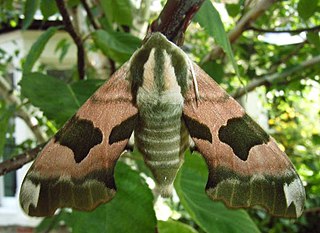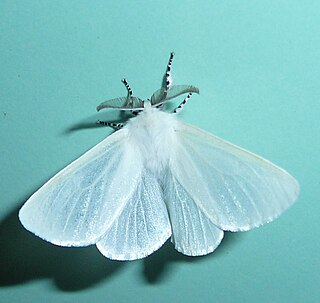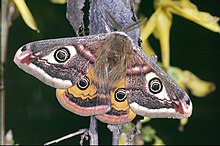
The cinnabar moth is a brightly coloured arctiid moth found as a native species in Europe and western and central Asia then east across the Palearctic to Siberia to China. It has been introduced into New Zealand, Australia and North America to control ragwort, on which its larvae feed. The moth is named after the red mineral cinnabar because of the red patches on its predominantly black wings. The species was first described by Carl Linnaeus in his 1758 10th edition of Systema Naturae. Cinnabar moths are about 20 mm (0.79 in) long and have a wingspan of 32–42 mm (1.3–1.7 in).

Saturniidae, members of which are commonly named the saturniids, is a family of Lepidoptera with an estimated 2,300 described species. The family contains some of the largest species of moths in the world. Notable members include the emperor moths, royal moths, and giant silk moths.

The common swift is a moth of the family Hepialidae. It was previously placed in the genus Hepialus. It is a common, often abundant European species. The species was described by Carl Linnaeus in his 1758 10th edition of Systema Naturae.

The scalloped oak is a moth of the family Geometridae. The species was first described by Carl Linnaeus in his 1758 10th edition of Systema Naturae.

The bordered white or pine looper, is a moth of the family Geometridae. Among these, it belongs to tribe Bupalini of the subfamily Ennominae. B. piniaria is a common species throughout the western Palearctic region, the Near East and North Africa. However, its presence in certain regions – e.g. the northern Balkans – is doubtful.

Mimas tiliae, the lime hawk-moth, is a moth of the family Sphingidae. It is found throughout the Palearctic region and the Near East, and has also been identified in Canada's east and western provinces and in northern Spain (Europe). The species was first described by Carl Linnaeus in his 1758 10th edition of Systema Naturae.

Laothoe populi, the poplar hawk-moth, is a moth of the family Sphingidae. The species was first described by Carl Linnaeus in his 1758 10th edition of Systema Naturae. It is found throughout the Palearctic region and the Near East and is one of the most common members of the family in the region. It is distinctive due to its habit of resting with its hindwings held further forward than the forewings.

The bright-line brown-eye is a moth of the family Noctuidae. The species was first described by Carl Linnaeus in his 1758 10th edition of Systema Naturae. It is a common species throughout Europe, but is also found in North Africa, temperate North Asia and Central Asia, Asia Minor, Syria, and Turkestan, northern India, China, Korea and Japan.

The shark is a moth of the family Noctuidae. The species was first described by Carl Linnaeus in his landmark 1758 10th edition of Systema Naturae.

The copper underwing, humped green fruitworm or pyramidal green fruitworm is a moth of the family Noctuidae. The species was first described by Carl Linnaeus in his 1758 10th edition of Systema Naturae.

Smerinthus ocellatus, the eyed hawk-moth, is a European moth of the family Sphingidae. The species was first described by Carl Linnaeus in his 1758 10th edition of Systema Naturae.

Hyles gallii, the bedstraw hawk-moth or galium sphinx, is a moth of the family Sphingidae. The species was first described by S. A. von Rottemburg in 1775.

Macrothylacia rubi, the fox moth, is a lepidopteran belonging to the family Lasiocampidae. It was first described by Carl Linnaeus in his 1758 10th edition of Systema Naturae.

The orange swift or orange moth is a moth belonging to the family Hepialidae. The species was first described by Carl Linnaeus in 1761 and was previously placed in the genus Hepialus. It is distributed throughout Europe.

Erebia ligea, the Arran brown, is a member of the subfamily Satyrinae of the family Nymphalidae. This brown is widespread in south-eastern and northern Europe. It prefers mixed woodlands at low altitudes. It is rarely seen in open areas. This species was first described by Carl Linnaeus in his 1758 10th edition of Systema Naturae, and the type locality is Sweden.

Arctia villica, the cream-spot tiger, is a moth of the family Erebidae. The species was first described by Carl Linnaeus in his 1758 10th edition of Systema Naturae. It is distributed from the Iberian Peninsula, Anatolia, western and northern Iran, western Siberia, southwestern Asia and North Africa.

Utetheisa pulchella, the crimson-speckled flunkey, crimson-speckled footman, or crimson-speckled moth, is a moth of the family Erebidae. The species was first described by Carl Linnaeus in his 1758 10th edition of Systema Naturae.

Euthrix potatoria, the drinker, is an orange-brown moth of the family Lasiocampidae.

Calliteara pudibunda, the pale tussock, is a moth of the family Erebidae. The Dutch common name for the moth (Meriansborstel) comes from the butterfly and insect painter Maria Sibylla Merian. The species was first described by Carl Linnaeus in his 1758 10th edition of Systema Naturae. It is found in Asia and Europe.

Leucoma salicis, the white satin moth or satin moth, is a moth of the family Erebidae. The species was first described by Carl Linnaeus in his 1758 10th edition of Systema Naturae. It is found in Europe including the British Isles but not the far north. In the east it is found across the Palearctic to Japan. Also in North America where it was introduced in the 1920s.

























